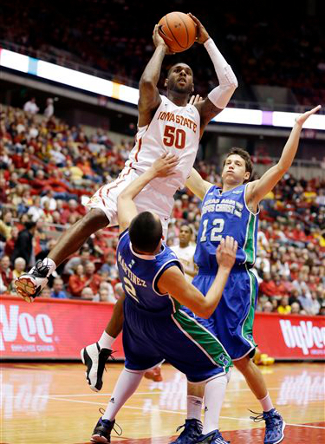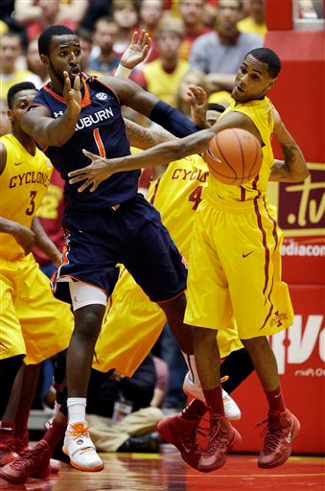Erwin Center | Austin, TX | Tip: 3 P.M. CT | TV: Big 12 Network (Affiliate list)/ESPN3 Texas is back in action this afternoon, hosting a Top 10 opponent at the Drum. The Horns are coming off one of their most impressive performances of the season, a convincing road win in which they stifled the West Virginia offense and scored at will on the other end. UT’s defense held the Mountaineers to their lowest offensive efficiency mark of the season, allowing just 0.936 points per possession. The Texas defense will need another strong performance this afternoon against an Iowa State squad that has the 26th-most efficient offense in the nation. The Cyclones get down the court in a hurry and find open shooters with just one or two passes, often scoring before their opponents even know what’s happened. This game is an important opportunity for the Longhorns, who will likely be battling on the NCAA bubble all season long. In Joe Lunardi’s Thursday Bracketology update, UT was the last team left out of the field of 68. The bubble is just a bit smaller this season, as the formation of the American Athletic Conference means that there’s one less at-large bid available.
Fred Hoiberg is a little confused about today’s game Texas is currently ranked 46th in the RPI, but are lacking any wins against teams ranked in the RPI Top 50. Thanks to North Carolina’s swoon in ACC play, the Tar Heels have slid to 53rd, leaving Texas with an 0-4 mark against the RPI Top 50. Fortunately, the Big 12 is the top league as ranked by RPI, and the Horns will have an additional 10 chances to knock off a team in that important Top 50 group. Obviously, it’s easier to upset any team at home than on the road, and that’s especially true when talking about teams like Iowa State, Kansas State, and Kansas, who have tremendous home-court advantages. If the Horns want to finish at least .500 in league play and maintain an NCAA-worthy résumé, they will have to earn some wins at home against the Big 12’s top teams. By the numbers Iowa State’s aforementioned efficient offense is a quick-strike unit that can easily exploit even the smallest mistakes made by opposing defenses. The Cyclones play at the 16th-fastest tempo in Division I, and they boast the 7th-quickest offensive possessions, averaging just 14.7 seconds on the offensive end. Iowa State not only attacks in transition, but also repeatedly scores on the secondary break by finding open men when the defense does manage to stop the ball. The Cyclones are very disciplined when they run the floor, staying in their lanes and getting to spots where they can wait for open looks, or cutting to the rim on the weak side. Defensively, Iowa State’s numbers are even better. The Cyclones have the 18th-most efficient defense in the country, allowing just 0.929 adjusted points per possession. They have a lot of length on the perimeter, which allows them to sag off and defend the interior, while still being able to close out on shooters for contested jumpers. As a result, Iowa State has a fantastic two-point defense and hardly ever sends opponents to the line. With the Cyclone D already set inside, driving guards have to pass it off, take a contested shot, or barrel forward and draw offensive fouls. In Big 12 play, Iowa State’s defense has also started forcing mistakes. The Cyclones hardly ever forced turnovers in the non-conference slate, but are tops in the conference with a 23% defensive turnover percentage in four league games. That increase in turnovers has helped to offset a decrease in defensive rebounding, as the smaller Cyclone roster has given up more second chances now that they are battling the size of Big 12 teams. Meet the Cyclones An Iowa State name that most Big 12 fans will already know is that of Georges Niang (No. 31), a matchup nightmare that could best be described as a point forward. Although Niang doesn’t run the point, he has the ballhandling skills to do so, is an excellent passer, and can get to the rack by driving from the perimeter. Niang doesn’t have the speed to blow by defenders, but he can pull opposing forwards away from the bucket, put the ball on the floor, and use smooth spin moves to beat them to the rim. When faced with smaller defenders, Coach Hoiberg loves to isolate him on the block, where Niang can easily score over both shoulders.
Defenses have a tough time slowing down DeAndre Kane If Niang wasn’t already enough of a matchup problem for opponents, the Cyclones went and added graduate transfer DeAndre Kane (No. 50) to run the point. A 6’4″ guard, Kane has an aggressive streak that gets him to the rim repeatedly and makes him a handful on the glass. Kane always has a head of steam in transition, where his speed and strength make him tough to slow down. Even when he’s stopped on the break or on the drive, he makes excellent passes to set up teammates. And if opponents sag off to take away his driving ability, Kane can knock down the three, as his 35.9% success rate proves. The former Marshall player has been putting up ridiculous numbers all season, but he has earned a lot of attention with his stats in Big 12 play. Through four games, Kane is averaging 22.3 points, 6.8 rebounds, 5.5 assists, and 3.5 steals. While Iowa State’s pace means that he has a few more possessions to earn those stats, the numbers are still staggering. Freshman Matt Thomas (No. 21) had started every game this season before coming off the bench in Monday’s loss to Kansas. Thomas came to Ames with the reputation of a sharpshooter from his high school days in Wisconsin, but he has not taken too many shots in his first year at ISU. He’s only used 16% of the team’s shots when he’s on the floor, but is reliable enough as a spot-up guy, having knocked down 33% of his threes. Sophomore Naz Long (No. 15) is the man who took Thomas’ starting spot on Monday night, and he’s the team’s only lights-out option from beyond the arc. Under Hoiberg, Iowa State has historically been a team that can bury you with threes, but this year’s team is only average with a 34.3% mark from long range. Long is the main reason that percentage isn’t worse, as he’s leading the team in both three-point attempts (72) and percentage (44.4%). On the wing, senior Melvin Ejim (No. 3) is a good shooter and quick slasher who can be tough to stay in front of. His 35% three-point mark keeps defenders honest and helps him use head fakes to get space for drives to the lane or one-dribble pull-up jumpers just inside the arc. Ejim posted some phenomenal rebounding numbers as a junior, stats that were made even more impressive when considering he’s just 6’6″. This year, those numbers have been cut nearly in half, with Melvin’s rebounding percentages not even cracking the Top 500 on either end of the court. Although Dustin Hogue (No. 22) is also 6’6″, his mindset is more consistent with that of a power forward. Hogue is always scrapping inside for boards, and his 22.6% defensive rebounding rate ranks him in the Top 100 nationally. He is also the team’s best offensive rebounder and boasts a nice shooting percentage because of how many easy looks he earns for himself with hard work on the glass. Even when he’s not getting second-change points, he has the skills to get good opportunities inside, despite being undersized. The Iowa State bench is very short, with no options to back up Niang, Ejim, or Hogue. Freshman guard Monte Morris (No. 11) is the final player in the core, seven-man rotation, and he averages just over 22 minutes per game. Morris has speed and good handles, but can sometimes look a little too hyped-up and jittery when he’s trying to dribble penetrate. Morris also appears to have a pretty nice three-point stroke, but doesn’t have much of a sample size on which to judge. The freshman has made nearly 39% of his threes, but is averaging less than one make per game. Keys to the game 1) Dominate the glass – Iowa State’s defense forces opponents into taking contested jumpers, which typically means a lot of missed shots. Texas has done a good job reclaiming their misses this year and turning those into points, while the Cyclones have struggled on the defensive glass in conference play. If the Longhorns aren’t exploiting that advantage and earning second chances against an ISU team that will force a lot of misses, they will have a hard time keeping up on the scoreboard today.
Iowa State’s interior defense can frustrate opponents 2) Knock down threes – With the Cyclones sagging into the paint and taking away Texas’ interior game, it means that the Longhorns are going to have to knock down their open threes. Oklahoma found a lot of success with the drive-and-kick in their win over Iowa State last Saturday. The Longhorns need to do the same this afternoon, with Damarcus Croaker and Martez Walker playing the role of spot-up shooter. Texas can also probably find some success with Jonathan Holmes and Connor Lammert utilizing their pick-and-pop skills. 3) Don’t over-penetrate – Javan Felix and Isaiah Taylor have both made their share of mistakes this season by driving against set defenses and getting themselves into trouble. While Texas will need both Felix and Taylor to be aggressive this afternoon, they have to be smart about reading what the defense is giving them. If not, it will result in senseless turnovers that will fuel Iowa State’s transition game. 4) Maintain poise – In Iowa State’s 14-0 start, eight of those wins came after the Cyclones dug out of a hole of at least seven points. Thanks to their ability to score in a hurry, it doesn’t take long for the Cyclones to steal momentum and erase deficits. The Longhorns are going to have to weather a few runs from Iowa State today if they want to pull off the upset, so they have to maintain composure when the Cyclones inevitably get on a roll. |











